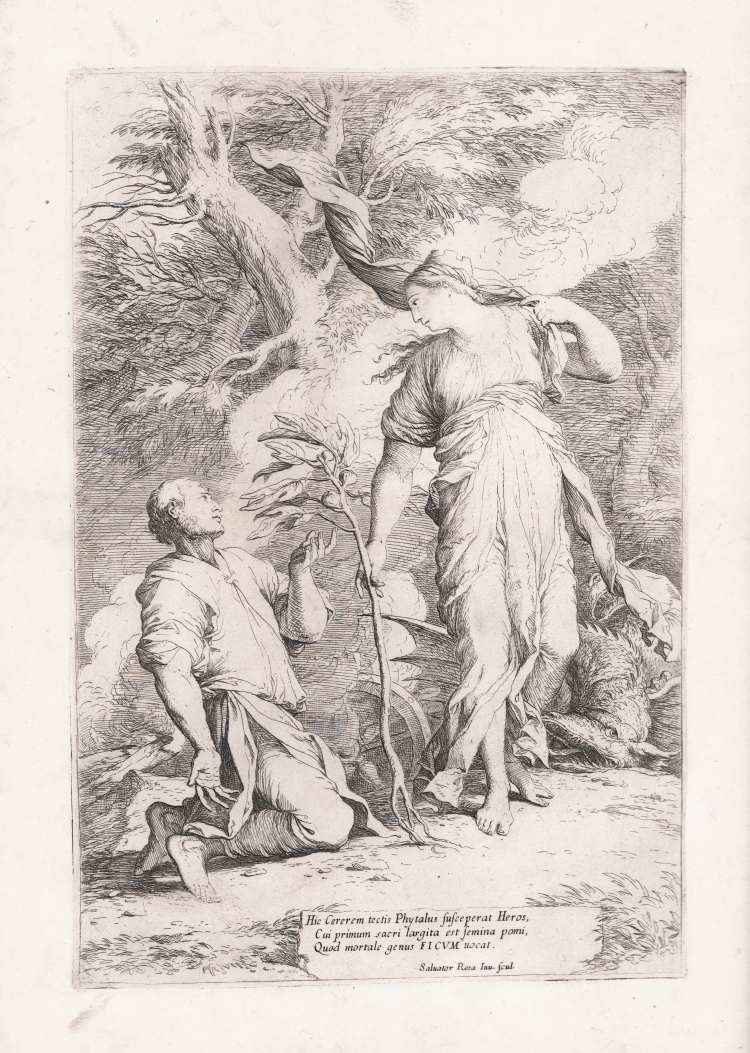




| Reference: | S24578 |
| Author | Salvator ROSA |
| Year: | 1662 ca. |
| Measures: | 235 x 355 mm |



| Reference: | S24578 |
| Author | Salvator ROSA |
| Year: | 1662 ca. |
| Measures: | 235 x 355 mm |
Ceres and Phytalus; to left, Phytalus, kneeling, receives the fig tree from the goddess Ceres, standing to right, as a reward for his hospitality. Etching and drypoint, circa 1662, signed at lower center.
Example of the second state of two with the plate retouched in Phytalus's right foot and in the profile of Ceres, to which a third lock of hair is also added.
A fine impression, printed on contemporary laid paper with "fluer-de-lys in a circle with grapes" watermark, wide margins, very good condition.
The work describes the myth of Ceres that, hosted by Phytalus in his home, gives him the fig tree, which was hitherto unknown to men, as a sign of gratitude.
Some scholars argue that the subject is inspired by the Life of Theseus of Plutarch and others that the work is more banally due to the predilection of the artist for the fruit of the fig tree.
The work is mentioned in a letter written by Salvator Rosa to his friend Ricciardi in 1662 from his hermitage in the villa of Strozzavolpe near Poggibonsi, along with other famous works: Polycrates, Democritus, Alexander and Diogenes, Plato's Academy, Diogenes Throwing the Bowl, and the Death of Atilius Regulus. We can therefore conclude that 1662 was a particularly happy and fruitful year for the engraver Rosa, who linked his fame as a great graphic artist to the copperplates executed during this period. The subject depicted in our print illustrates the myth of Ceres who, hosted by Phytalius in his home, gives him the fig tree hitherto unknown to man, as a sign of gratitude. The source from which Rosa draws inspiration in her learned readings is to be found in Pausanias' Periegesis tes Ellados (I, 37, 24) or in Plutarch's Life of Theseus (chap. XXIII), but some critics have linked this subject with the artist's known predilection for the fig fruit, reported by his biographer Baldinucci. The scene depicted in the engraving appears marked by a classical composure, although it has been noted that the attitudes of the two figures derive from the mimicry of contemporary theatre, widely known and practised by the artist” (cfr. Massari, Tra Mito ed Allegoria, p. 446).
Bibliografia
Bartsch / Le Peintre graveur (XX.275.19); Wallace 1979 / The Etchings of Salvator Rosa (112.II); Salamon 98; S. Massari, Tra Mito ed Allegoria, p. 446, 170, II/II.
Salvator ROSA (Napoli 1615 - Roma 1673)
|
Like Testa, Castiglione and Della Bella, Salvator Rosa considered the art of engraving the best technique to express his talent and, it is not by chance that he is considered, together with the already mentioned artists, one of the protagonists of Italian seventeenth-century art.
Rosa was an extremely eclectic person; his main models in art were the classicism of Carracci, the naturalism of Ribera, the contemporary Roman painting and the ancient world.
From the latter in particular, Rosa drew inspiration for his engravings, whose subjects come from the old Stoic philosophy, with the glorification of virtues though allegories. We have also to consider his passion for esotericism, which inspired him with pictorial compositions with necromancy.
His technique and total command of etching enabled his prints to be appreciated even from his contemporaries, copied by them and highly requested by collectors.
|
Salvator ROSA (Napoli 1615 - Roma 1673)
|
Like Testa, Castiglione and Della Bella, Salvator Rosa considered the art of engraving the best technique to express his talent and, it is not by chance that he is considered, together with the already mentioned artists, one of the protagonists of Italian seventeenth-century art.
Rosa was an extremely eclectic person; his main models in art were the classicism of Carracci, the naturalism of Ribera, the contemporary Roman painting and the ancient world.
From the latter in particular, Rosa drew inspiration for his engravings, whose subjects come from the old Stoic philosophy, with the glorification of virtues though allegories. We have also to consider his passion for esotericism, which inspired him with pictorial compositions with necromancy.
His technique and total command of etching enabled his prints to be appreciated even from his contemporaries, copied by them and highly requested by collectors.
|